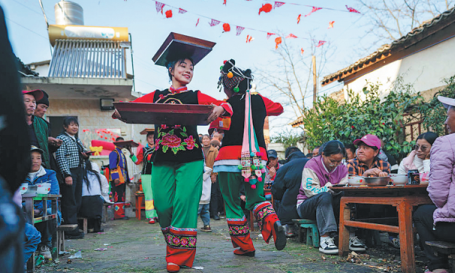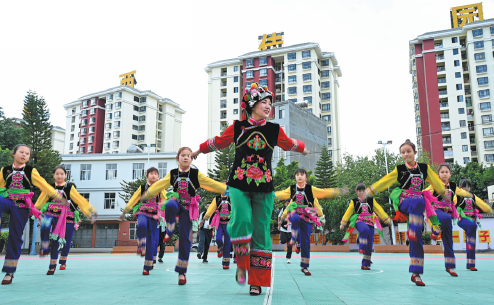Inheritor dances in dedication to preserving precious culture

NPC deputy promotes folk songs, rhythms of the Yi ethnic group in schools
Lu Lihua, a provincial-level inheritor of the national intangible cultural heritage "dage", a kind of Yi ethnic folk song and dance, and a deputy to the 14th National People's Congress from Southwest China's Yunnan province, has dedicated 14 years to the preservation and promotion of ethnic culture and rural vitalization.
Born in 1987 in Fengxian village, Nanjian Yi autonomous county in Dali Bai autonomous prefecture, Lu is a member of the Yi ethnic group. Growing up in this area known for its abundance of Yi ethnic culture, she learned a lot of traditional folk songs and dances from the elders during her childhood.
In 2011, Lu quit her job as an actress of ethnic song and dance in Kunming, capital of Yunnan, and returned to Nanjian to join the local tiaocai art troupe, dedicating herself to the preservation and promotion of intangible cultural heritage and grassroots cultural work.
Through her tireless efforts, Nanjian, known as the birthplace of two Yi ethnic cultural practices — dage and tiaocai — now thrives with over 300 folk dance troupes and more than 2,000 performers.
Dage is a traditional form of recreation where people form a circle around a fire and dance and sing in a rhythmic manner. Tiaocai is a food-serving style that combines dance, music, acrobatics and dining traditions. Both art forms were designated as national intangible cultural heritage projects in 2008.
"Both the dage and tiaocai customs serve to bolster social cohesion and foster communication and integration among communities," Lu said.
In 2023, she was elected as an NPC deputy. Since then, about half of the 11 proposals she has proposed focus on ethnic cultural protection and rural vitalization.
Last year, she called for the establishment of a major pilot project for the systematic protection and sustainable development of intangible cultural heritage at the national two sessions, aiming to promote the deep integration of traditional craftsmanship inheritance and the cultural tourism industry.
Thanks to her initiative, the Nanjian Tiaocai 2008 Creative Park, spanning over 5,000 square meters, opened earlier this year. This project makes use of residential buildings, old homesteads and idle rural land to become a tourism resort. It promotes a range of businesses such as banquet reception, skill inheritance, study tours and sales of agricultural products.
By boosting economic benefits for communities and increasing local incomes, the project is expected to enhance vitalization of the county.
"Despite overall positive trends in the preservation of these intangible cultural heritage projects, several challenges still exist," she said.
Lu noted issues such as insufficient funding, a scarcity of talent, limited market recognition, as well as the aging of the inheritors. Unstable incomes frequently prompt young practitioners who have acquired the art to switch their professions, posing a risk for the continuous transmission of the intangible cultural heritage.
To tackle those challenges, Lu has integrated the folk arts with various industries like catering, wedding services and tourism, which has created job opportunities for tens of thousands of locals directly or indirectly, she said.
Lu has also actively promoted the inclusion of intangible cultural heritage in the school curriculum in Nanjian. By introducing these valued traditions into education, she aims to inspire children to appreciate and protect their cultural heritage.
Lu said she will carry on the protection and promotion of the intangible cultural heritage by developing a better training mechanism for the inheritors and encouraging more young people to participate.
She will also work with enterprises and government departments to develop cultural projects and boost rural vitalization.
Contact the writers at dengrui@chinadaily.com.cn























